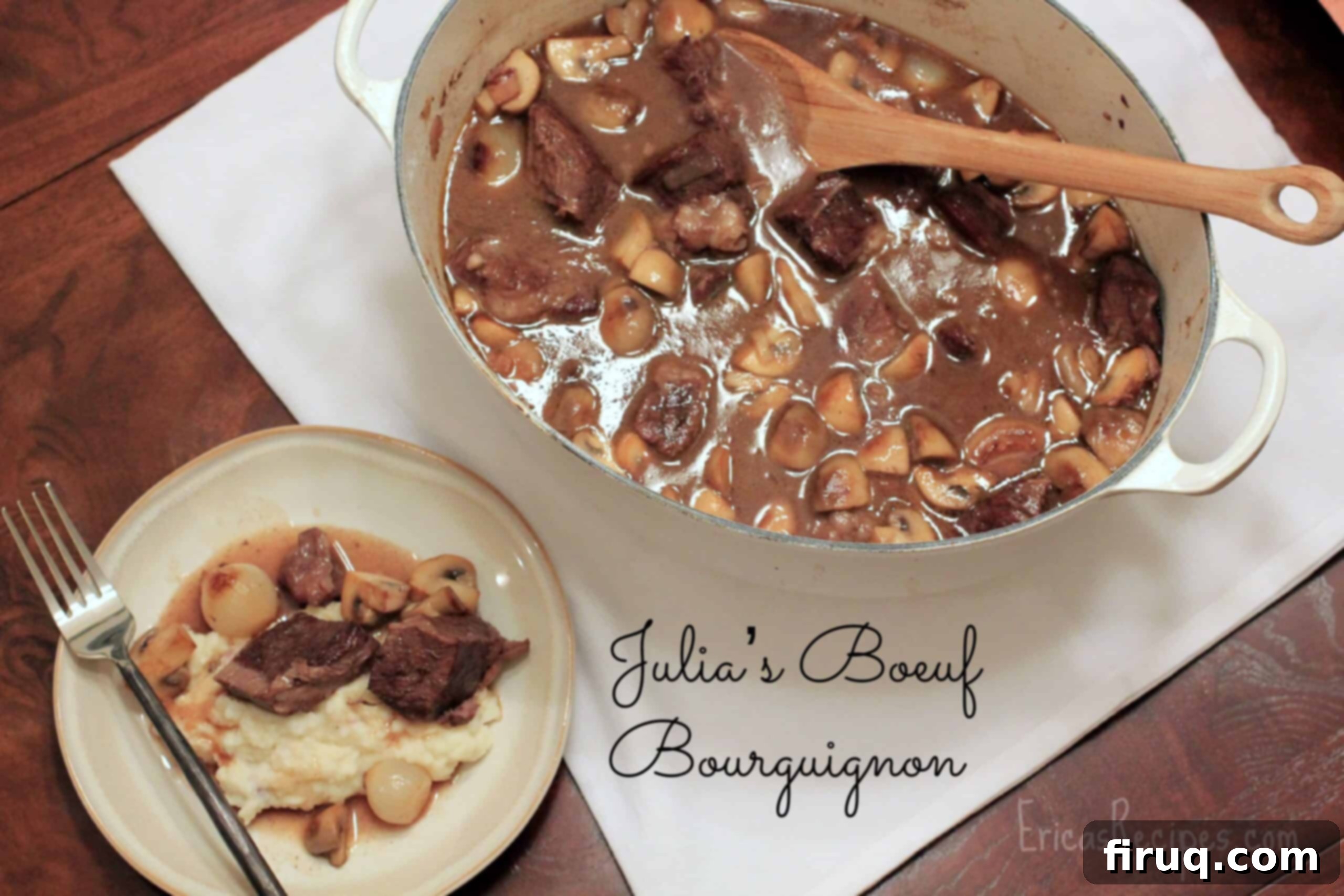Mastering Julia Child’s Boeuf Bourguignon: A Timeless French Culinary Journey
Embarking on the creation of Julia Child’s iconic Boeuf Bourguignon is more than just cooking a meal; it’s an immersive culinary adventure, a rite of passage for anyone passionate about French cuisine. This legendary dish, synonymous with the incomparable Julia Child, is every bit as challenging and glorious to prepare as its reputation suggests, consistently living up to its grand expectations. Whether you are a seasoned professional chef, a passionate food blogger, or a dedicated home cook aiming to delight your family, crafting this masterpiece at least once in your lifetime is an absolute must. It’s a journey into the heart of French country cooking, promising rich flavors, tender textures, and an unforgettable dining experience.
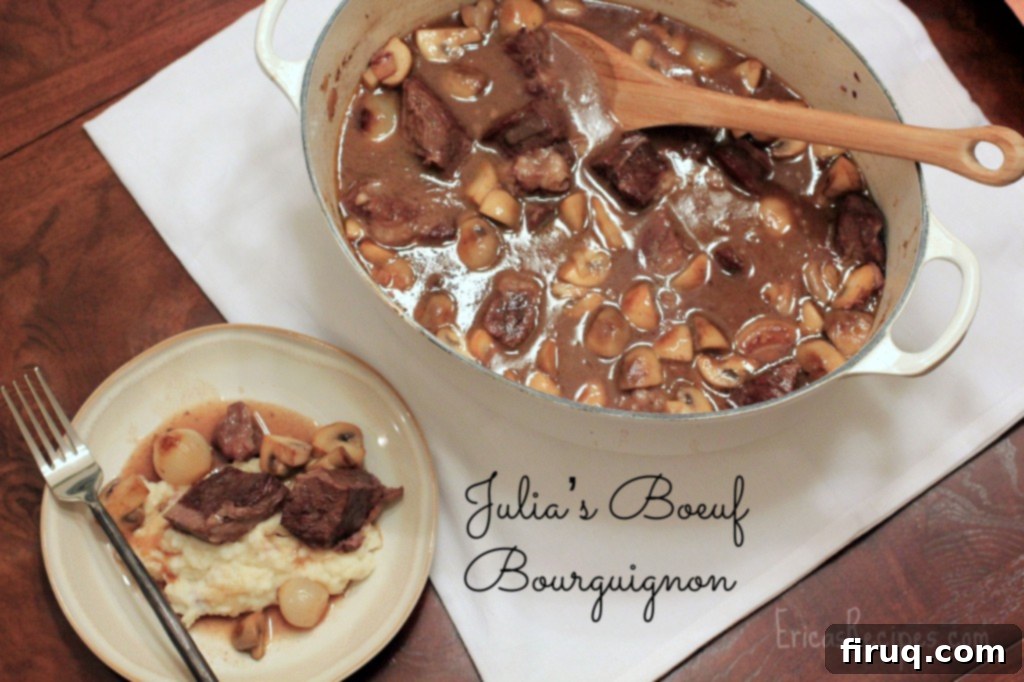
I did it. After years of admiring, contemplating, and perhaps a little trepidation, I finally conquered Julia Child’s Boeuf Bourguignon. The sense of accomplishment was truly monumental, akin to reaching a significant life milestone. It was a glorious, deeply satisfying experience that transcended mere cooking. From the meticulous preparation to the fragrant simmer, every step felt like a tribute to Julia’s legacy and a testament to the enduring power of classic French culinary techniques. The kitchen transformed into a sanctuary of aromas and anticipation, and the final dish was nothing short of perfection.
The process itself is an intricate dance of flavors and textures, a culinary symphony orchestrated by the master herself. What makes Julia’s Boeuf Bourguignon truly special is that it’s not just a single stew; it’s an artful assembly of three distinct components, each prepared with precision to contribute to the dish’s incredible depth:
- The Beef Stew: A robust foundation of tender, slow-braised beef in a rich, savory red wine sauce.
- Braised Pearl Onions: Sweet, delicate onions cooked until translucent and tender, offering bursts of subtle flavor.
- Browned Mushrooms: Earthy, perfectly caramelized mushrooms that add an essential layer of umami.
Each element plays a crucial role, building layers of complexity that ultimately define this iconic dish. The beauty lies in their individual preparation and their harmonious integration.
My culinary journey began with the indispensable assistance of my 11-year-old daughter, who enthusiastically took on the crucial tasks of cooking the bacon and browning the meat. Her eager involvement added a heartwarming dimension to the entire experience, transforming a challenging recipe into a shared family endeavor. It was a wonderful opportunity to introduce her to the joys and intricacies of classic cooking, fostering a love for food and the art of creation. Her careful handling of the initial steps set the stage for the rich flavors that would soon develop.
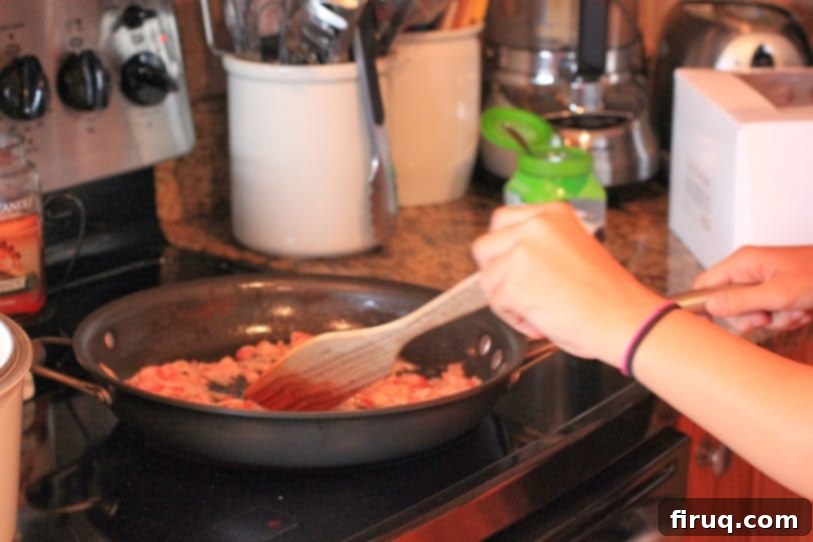
While Julia specified 2-inch beef cubes, mine ended up being more like generous rectangles. But in the grand scheme of a slow-cooked, tender stew, the exact geometry matters less than the quality of the meat and the love put into its preparation. The key is to have substantial pieces that can withstand long braising without falling apart too quickly, yet become meltingly tender with every bite. I used high-quality beef chuck, trimmed meticulously to ensure the best texture and flavor. The browning step is absolutely critical here, as it creates a deep, caramelized crust that locks in juices and builds the foundational flavors of the stew. This Maillard reaction is where much of the magic happens, transforming simple beef into something extraordinary.
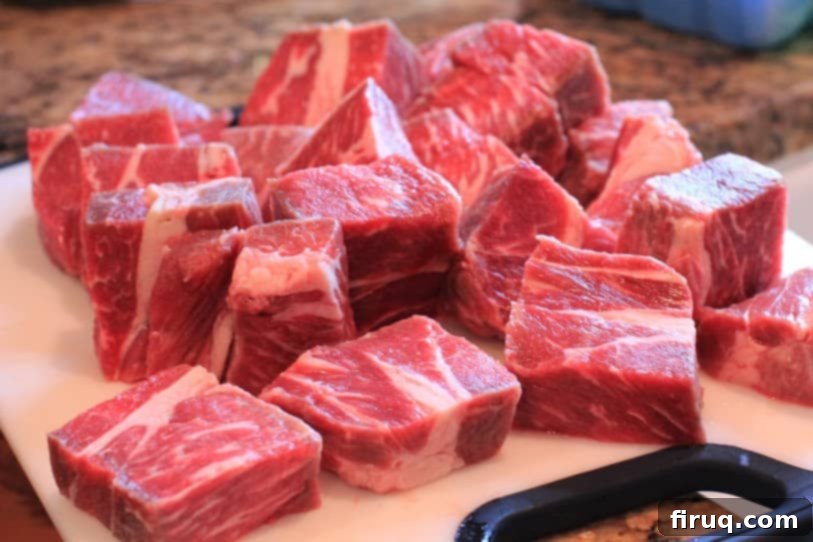
After rendering the bacon until crisp and golden, I carefully removed it, reserving the flavorful fat. This fat would become the essential medium for browning the beef, imparting a smoky richness right from the start. Each batch of beef was browned patiently, ensuring a beautiful, even crust on all sides before being transferred to a sturdy Dutch oven. This slow, deliberate browning process cannot be rushed, as it is foundational to the depth of flavor in the final dish. Seasoning the meat generously with kosher salt and freshly cracked black pepper at this stage is also vital, building flavor from within.
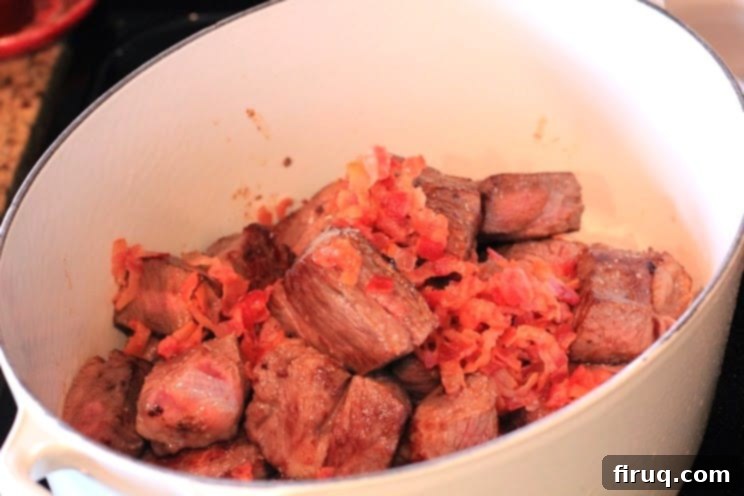
Once the beef was perfectly browned, the next step involved building the aromatic base. Into the same skillet, still infused with the rich remnants of bacon fat and beef drippings, went the sliced onions and carrots. These vegetables, often referred to as a mirepoix, are gently sautéed until softened and lightly caramelized, releasing their sweet and savory essences. This step extracts even more flavor from the pan, contributing to the complex tapestry of tastes that define Boeuf Bourguignon. Their sweetness balances the richness of the meat and wine, creating a well-rounded profile.
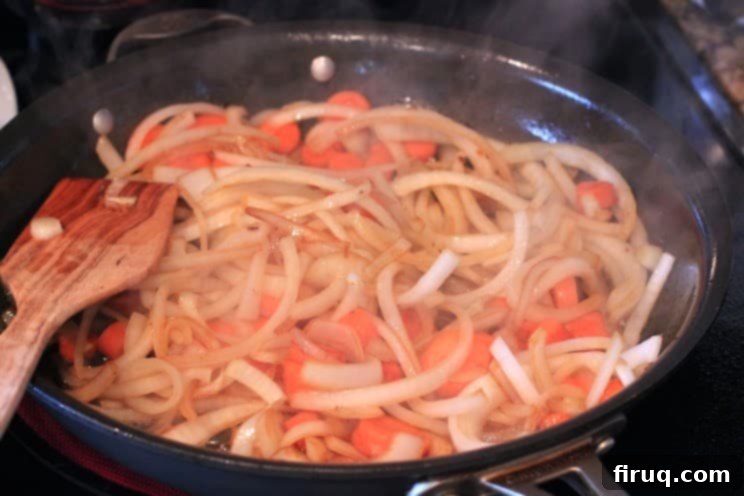
With the beef and aromatics now in the Dutch oven, it was time to introduce the soul of Boeuf Bourguignon: the red wine. After the vegetables were transferred, the skillet was deglazed with a bottle of robust Pinot Noir. Deglazing is a crucial technique where liquid (in this case, wine) is added to a hot pan to dissolve the browned bits (fond) stuck to the bottom, releasing intense flavor. This rich, wine-infused liquid, along with diced tomatoes, the crisp bacon, and a meticulously prepared bouquet garni (a bundle of herbs like parsley, cloves, garlic, bay leaf, and thyme tied in cheesecloth), was added to the pot. Finally, enough beef stock was poured in to generously cover the meat, ensuring a tender, moist braise. The Dutch oven, now brimming with potential, was sealed and placed into the oven to simmer for two glorious hours, allowing the flavors to meld and deepen.
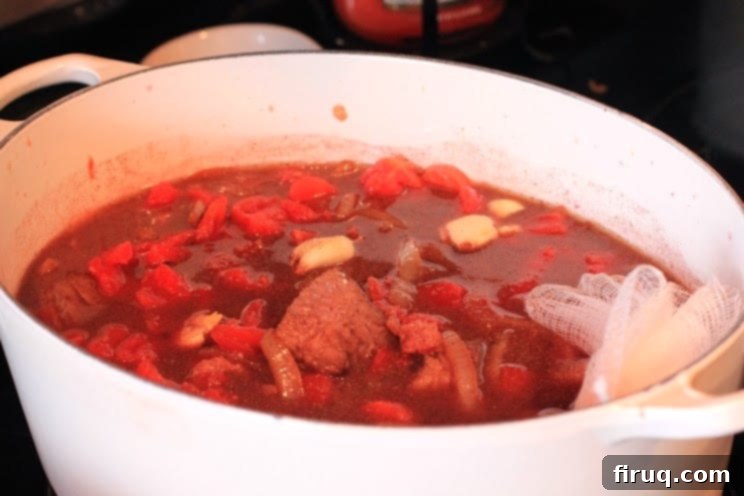
While the beef stew slowly transformed in the oven, my attention turned to the delicate pearl onions, another hallmark of this classic dish. The preparation of pearl onions requires a little finesse. First, they are blanched briefly in boiling water, then immediately shocked in cold water. This makes peeling the skins much easier. Once peeled, a small ‘x’ is scored into the root end of each onion. This seemingly minor step is incredibly important: it helps the onions cook evenly, allowing them to absorb the braising liquid more effectively and become wonderfully tender without disintegrating. These small, sweet onions, once braised, provide a wonderful contrast to the rich beef, adding both flavor and visual appeal to the final presentation.
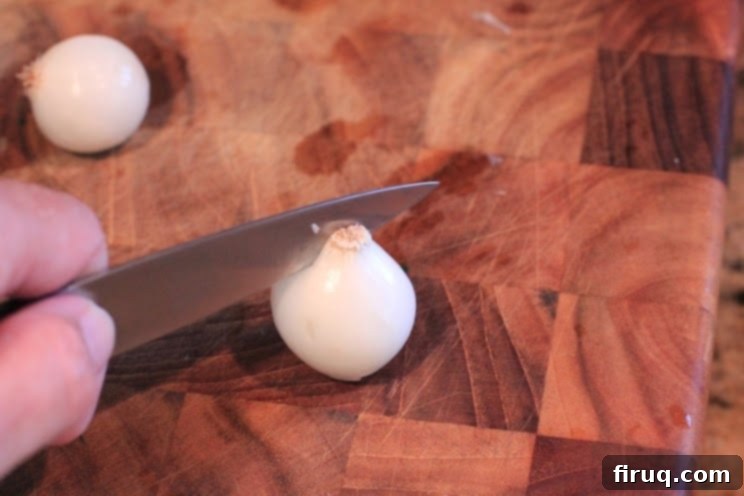
After being scored, the pearl onions are lightly browned in butter, developing a subtle caramelization before being gently simmered in chicken stock. This two-step cooking process ensures they are both flavorful and perfectly tender, retaining their delicate structure. The gentle braising in chicken stock infuses them with moisture and a savory depth that complements the richness of the main stew beautifully. It’s these thoughtful, separate preparations that elevate Julia’s Boeuf Bourguignon from a simple stew to a truly refined dish.
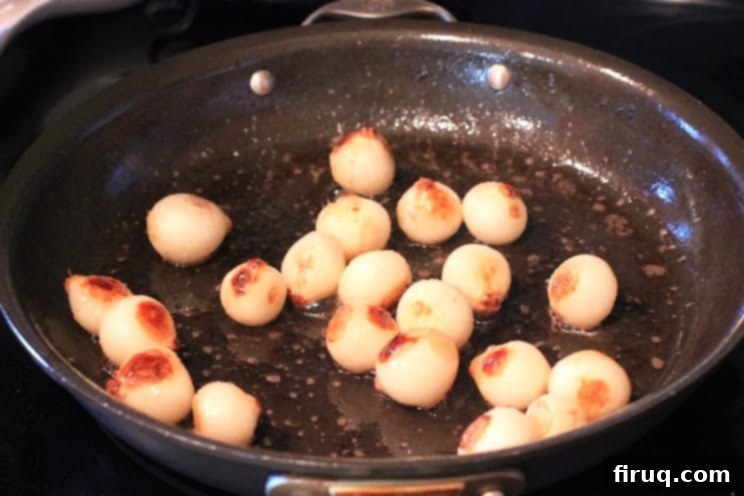
The final component, the mushrooms, adds an essential earthy depth. Just before the beef stew finishes cooking, fresh button or cremini mushrooms are sautéed in butter until beautifully browned and fragrant. This process concentrates their flavor and gives them a wonderful texture. In my case, the mushrooms quickly absorbed the butter, indicating the need for a touch more olive oil to ensure they caramelized rather than steamed. Achieving that deep brown color is key, as it brings out their umami notes, making them a perfect complement to the rich beef and wine sauce. Once perfectly browned, they are set aside, ready to be added at the very end to retain their texture.
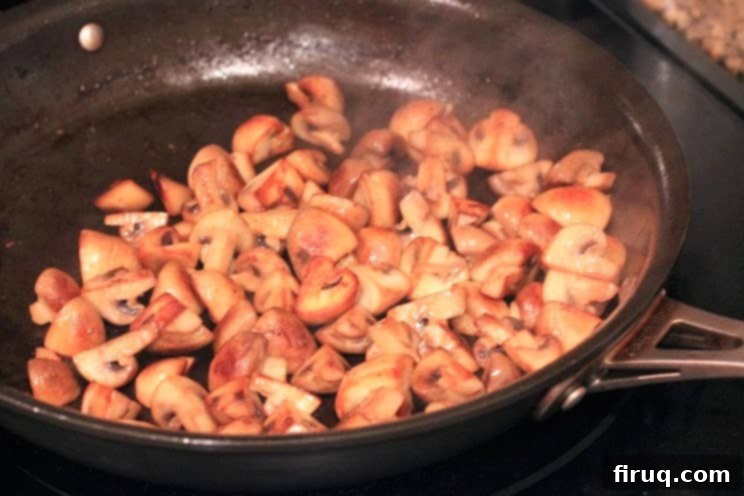
As the Boeuf Bourguignon emerged from the oven, its intoxicating aroma filled the entire kitchen, a testament to hours of slow cooking and meticulous preparation. Looking at the final photo of the dish, I found myself appreciating the uncleaned outside of the pot. It speaks to the authenticity of the cooking experience – real food being made, not just for aesthetics, but for pure enjoyment and flavor. This isn’t about pristine surfaces; it’s about the heart and soul poured into creating something truly delicious. The slight char on the pot’s exterior tells a story of dedicated simmering, of flavors developing over time, and of a meal truly crafted with passion. It’s a beautiful imperfection that symbolizes the hands-on nature of home cooking.
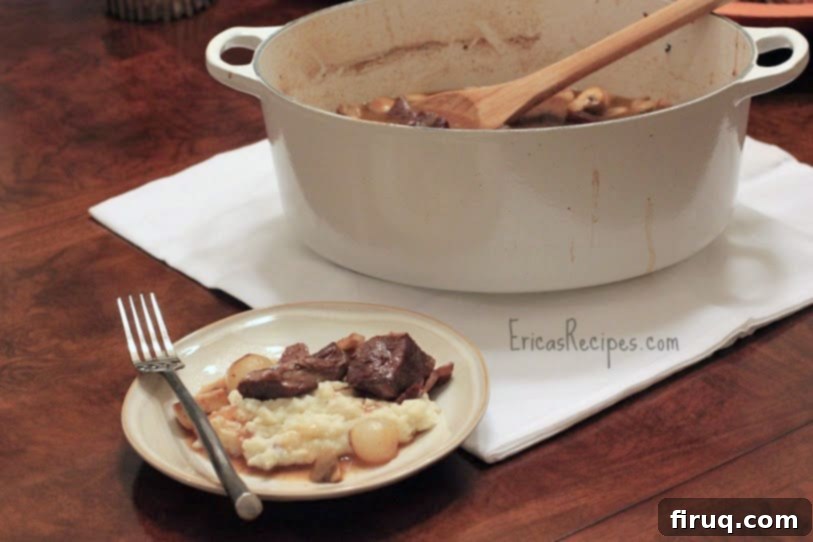
The true magic of Boeuf Bourguignon lies in the final assembly and the incredible sauce. Once the meat is tender, it’s carefully removed from the Dutch oven. The remaining liquid, along with the softened vegetables and bouquet garni, is strained. The spent aromatics and herbs are discarded, having given all their flavor. The resulting liquid is then skimmed of excess fat – a crucial step for a refined sauce – and gently reduced on the stovetop. This reduction intensifies the flavors, creating a rich, concentrated base. I learned firsthand the importance of sufficient reduction; my sauce was a little thinner than ideal, but still incredibly flavorful. To thicken it perfectly, a beurre manié (a paste of flour and butter) is whisked in, creating a luxurious, glossy sauce that clings beautifully to the meat. Finally, the braised pearl onions and browned mushrooms are returned to the pot with the beef, bathed in this glorious sauce, ready to be served. This symphony of textures and flavors is a testament to Julia Child’s genius and her ability to elevate simple ingredients into an extraordinary culinary experience.
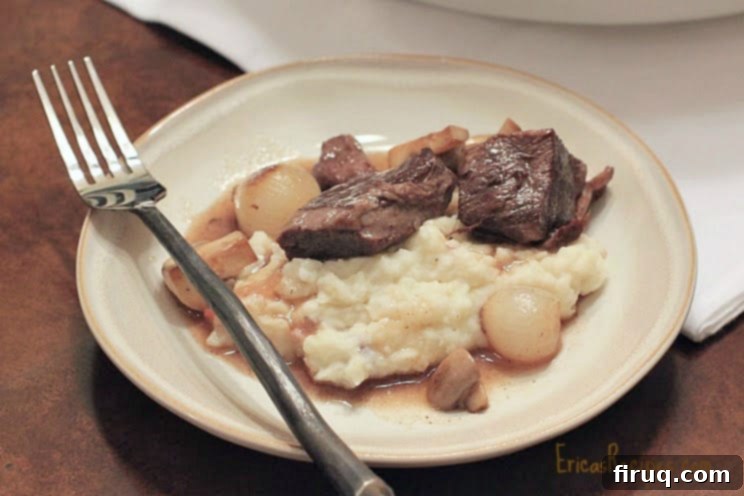
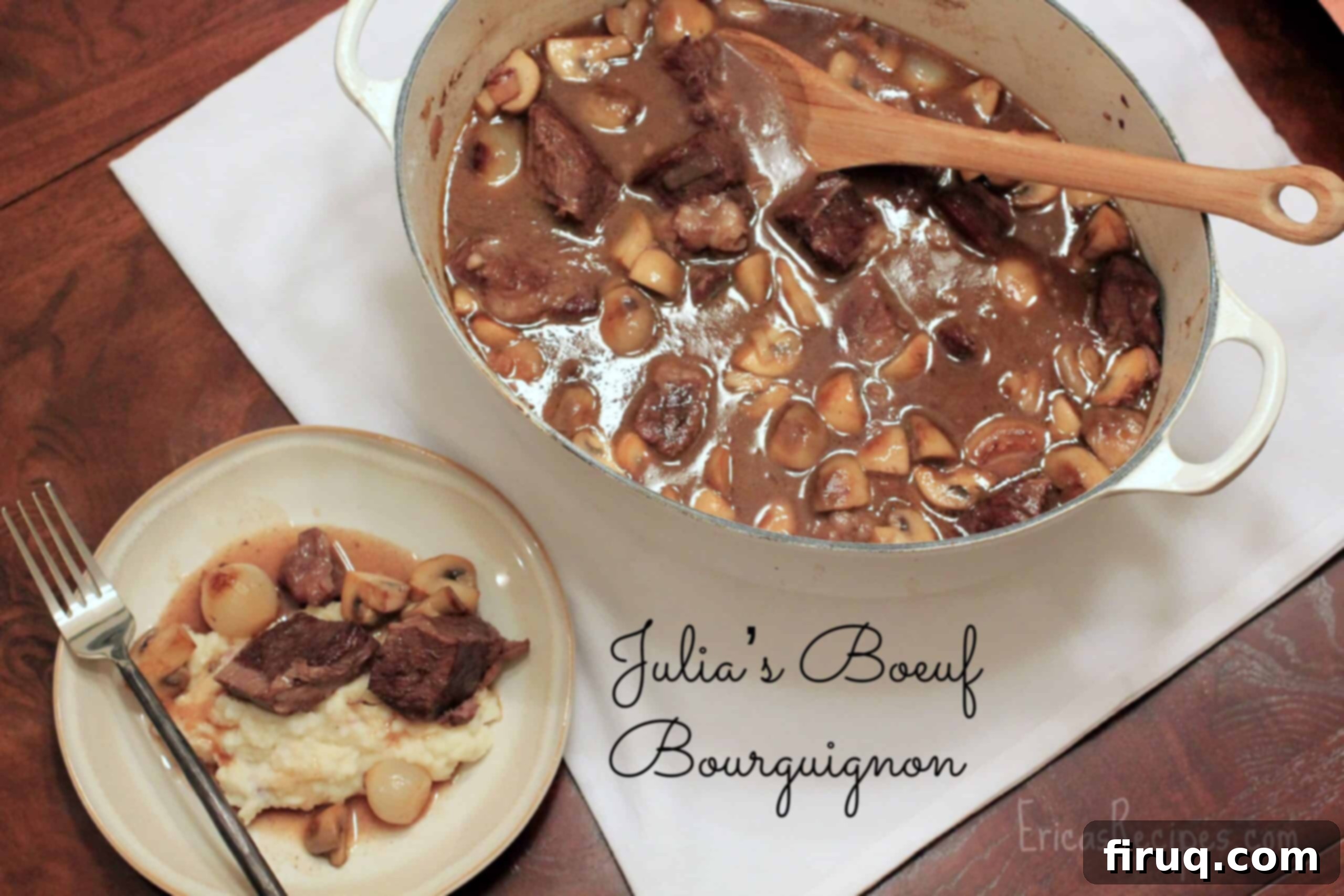
Julia’s Boeuf Bourguignon
Print
Pin
Rate
Ingredients
- 7 slices bacon cut into lardons (see *Note)
- 1 T extra virgin olive oil
- 4 lbs trimmed beef chuck cut into 2-inch cubes
- kosher salt and fresh cracked pepper
- 2 c sliced onions
- 1 c sliced carrots
- 1 bottle red wine Pinot Noir is a great choice
- 2 cups beef broth
- 1 can diced tomatoes drained
- bouquet garni 1/4 c flat-leaf parsley, 2 whole cloves, 3 smashed garlic cloves, 1 bay leaf, and 1 sprig thyme wrapped in cheesecloth and tied
- Beurre manié: 3 T flour mixed with 2 T unsalted butter to make a paste
- 24 pearl onions
- chicken stock
- unsalted butter
- 1 ½ pounds of button or cremini mushrooms quartered
- 1 recipe prepared Cream Cheese Smashed Potatoes roast potatoes, buttered noodles, or rice for serving
Instructions
-
Heat oven to 325F.
-
In a large skillet with 1 T olive oil, lightly brown the bacon. Remove with a slotted spoon and set aside.
-
Blot the meat with paper towels. Add the meat in batches so as not to overcrowd the pan, and brown in the bacon fat on all sides. Remove meat to a Dutch oven or large covered casserole dish. Season the meat with salt and pepper.
-
Discard the bacon fat leaving ~1-2 T in the skillet. Add the onions and carrots to the skillet and brown lightly. Transfer to the pot with the meat. Deglaze the skillet with the red wine, scraping up the browned bits with a wooden spoon. Add the wine to the pot with the meat. Also add the tomatoes, bacon, and bouquet garni. Add enough beef stock so there’s enough liquid to cover the meat. Put in the oven, covered, to simmer 2 hours.
-
Blanch the pearl onions 1 minute. Drain and rinse with cold water to stop the cooking. Cut off the end tips, remove the skins, and score an “x” in the root end. Heat a skillet with 1-2 T butter. Lightly brown the onions. Add enough chicken stock to half submerge the onions. Simmer gently 25 minutes or until tender.
-
When meat is almost done cooking, prepare the mushrooms. Heat 2 T butter in a large skillet. Add the mushrooms and cook until browned. Mine soaked the butter right up and looked a little dry, so I added a ~1T olive oil for them to cook properly. Once browned, remove the mushrooms from the heat and set aside.
-
Remove the Dutch oven from the oven. Using thongs, pick out the meat onto a dish. Strain the remaining liquids and such from the Dutch oven into a large saucepan. Discard the onions, carrot, and bouquet garni. Return the meat to the Dutch oven. Skim off as much fat as possible from the juices in the saucepan. Simmer liquid down to ~2 1/2 c (I didn’t do this enough, so my sauce was a little thin). Remove from the heat, whisk in the beurre manié, return to the heat, and simmer 2 minutes. Pour over the meat. Add the pearl onions and mushrooms. Serve over the starch of your choice which is traditionally roast potatoes – I made my Cream Cheese Smashed Potatoes.
Notes
Serving Julia Child’s Boeuf Bourguignon is the culmination of hours of dedicated effort, and the choice of accompaniment is just as important. Traditionally, it is served with roasted potatoes, which absorb the rich sauce beautifully. However, the versatility of this dish allows for other delicious options. I opted for my creamy, homemade Cream Cheese Smashed Potatoes, their smooth texture providing a delightful contrast to the tender beef. Buttered egg noodles or even a simple bed of fluffy rice are also excellent choices, each offering a different way to savor every last drop of the exquisite red wine sauce. No matter the starch, the Boeuf Bourguignon remains the undisputed star, a comforting and elegant centerpiece that speaks of warmth, tradition, and culinary excellence.
In conclusion, tackling Julia Child’s Boeuf Bourguignon is more than just following a recipe; it’s an educational and deeply rewarding experience that connects you to a rich culinary heritage. It teaches patience, precision, and the art of building layers of flavor. Every step, from browning the beef to patiently reducing the sauce, contributes to a final dish that is truly transcendent. It’s a testament to the fact that some of the greatest pleasures in life require time and effort. If you’ve ever hesitated to try this classic, consider this your invitation. The journey is as fulfilling as the destination, and the result—a glorious, soul-warming Boeuf Bourguignon—is a culinary achievement you will proudly cherish.
~✿♥✿~
